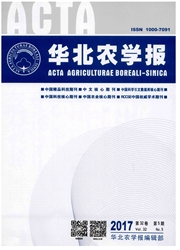

 中文摘要:
中文摘要:
Two genes(GhC4H1 and GhC4H2) that encode putative cotton cinnamate 4-hydroxylases that catalyze the second step in the phenylpropanoid pathway were isolated from developing cotton fibers. GhC4H1 and GhC4H2 each contain open reading frames of 1 518 base pairs(bp) in length and both encode proteins consisting of 505 amino acid residues. They are 90.89% identical to each other at the amino acid sequence level and belong to class I of plant C4 Hs. GhC4H1 and GhC4H2 genomic DNA are 2 247 and 2 161 bp long, respectively, and contain two introns located at conserved positions relative to the coding sequence. GhC4H1 and GhC4H2 promoters were isolated and found to contain many cis-elements(boxes P, L and AC-I element) previously identified in the promoters of other phenylpropanoid pathway genes. Histochemical staining showed GUS expression driven by the GhC4H1 and GhC4H2 promoters in ovules and fibers tissues. GhC4H1 and GhC4H2 were also widely expressed in other cotton tissues. GhC4H2 expression reached its highest level during the elongation stage of fiber development, whereas GhC4H1 expression increased during the secondary wall development period in cotton fibers. Our results contribute to a better understanding of the biochemical role of GhC4H1 and GhC4H2 in cotton fiber development.
 英文摘要:
英文摘要:
Two genes (GhC4H1 and GhC4H2) that encode putative cotton cinnamate 4-hydroxylases that catalyze the second step in the phenylpropanoid pathway were isolated from developing cotton fibers. GhC4H1 and GhC4H2 each contain open reading frames of 1 518 base pairs (bp) in length and both encode proteins consisting of 505 amino acid residues. They are 90.89% identical to each other at the amino acid sequence level and belong to class I of plant C4Hs. GhC4H1 and GhC4H2 genomic DNA are 2 247 and 2 161 bp long, respectively, and contain two introns located at conserved positions relative to the coding sequence. GhC4HI and GhC4H2 promoters were isolated and found to contain many cis-elements (boxes P, L and AC-1 element) previously identified in the promoters of other phenylpropanoid pathway genes. Histochemical staining showed GUS expression driven by the GhC4H1 and GhC4H2 promoters in ovules and fibers tissues. GhC4H1 and GhC4H2 were also widely expressed in other cotton tissues. GhC4H2 expression reached its highest level during the elongation stage of fiber development, whereas GhC4H1 expression increased during the secondary wall development period in cotton fibers. Our results contribute to a better understanding of the biochemical role of GhC4H1 and GhC4H2 in cotton fiber development.
 同期刊论文项目
同期刊论文项目
 同项目期刊论文
同项目期刊论文
 期刊信息
期刊信息
